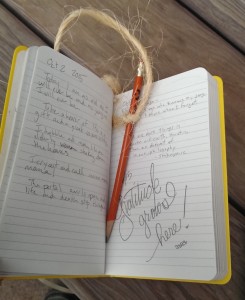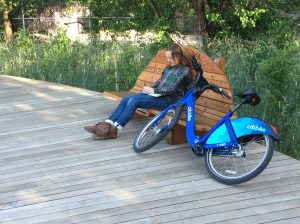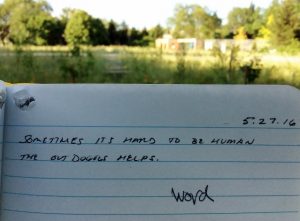
Over the past few years we have shared the thoughts and feelings left in the journals found under the bench in every Sacred Place that Nature Sacred has helped to create. These #Benchstories capture just a few of the thousands of journal entries written by visitors to the gardens over the years. In the journals we catch glimpses of the healing and transformative effects momentary time spent in nature can have upon the individual.
There is the initial discovery of the Sacred Place followed by a moment’s respite on the bench. While seated on the bench, the visitor may notice the cord attaching the journal to the bench or the protective box located under the bench where the journal is kept. From there the discovery may move to a reading of journal entries left by others. Finally, the peacefulness of the space lends itself to personal reflection or even the act of writing the entry itself allowing the visitor to discover something about her/himself that they weren’t aware of before.
And while some of these journal entries do express profound personal discovery, others simply share the more mundane moments of everyday life, the frustrations of a day-to-day job, teenagers sharing messages with friends through the journal, a joke or even a drawing. The one thing almost all of them have in common is that they reflect the impact a few moments of quiet, away from the stress of daily life, can have upon the individual.
The journals also often mirror the communities where they are located. Entries found at the Intersection of Change, a Sacred Place located in a neighborhood near the epicenter of the Baltimore Riots last spring, reflect the hopes and struggles of the area. At the Meditation Garden in the Western Maryland Correctional Institution inmates write about the mistakes they’ve made and the new person they hope to become. Journals in the many hospital-based Opens Spaces Sacred Places share a need for prayer and meditation for sick relatives or loved ones who’ve passed on.

Researchers at the University of Maryland analyzed more than 3,000 entries left in the journals at the Garden of Reflection and Remembrance, a Sacred Place on the University of Maryland campus. Words of encouragement were the most common entries found in the journals followed by thoughts of love. Other entries were more specific to college life such as school pride, the stress of academics, new romance, and struggles with the transitions that university life can bring.
Talk of depression, the loss of a friend or even suicide are also found in the journals. It is these entries that have some of the most profound effects on others as they respond by offering encouragement, love and support. Some writers even return to the journal later on to work through their thoughts or to let others know that they were through the worst of their troubles and getting better.

The Power of the Sacred Space
In today’s plugged in world it is hard to find time alone. Even when we are the only person around, our smart phones and connected devices pull us into the larger society in a way that couldn’t even be imagined 10, 15 or 20 years ago. When we turn to our phones, we are not just disconnecting with the people around us, but also from ourselves. Makes one wonder if ‘smart’ phones have actually made us smarter.
These Sacred Places and the journals offer not only a respite, but a safe place to spend quality time with ourselves to uncover, contemplate and express our innermost thoughts — something we rarely seem to have time to do nowadays. These entries can be written in complete anonymity and no one can publicly shame the writer on Facebook or other social media outlets. At the same time, the physical act of writing with a pen or pencil takes us to a different place than when we write with a keyboard. It causes us to slow down and connect with our personal feelings and thoughts. We can more fully explore these mental ramblings well beyond the constraints of 140 characters, or emojis, thus allowing us to be more authentically ourselves — again, something we rarely seem to get to be. Combined with the safety and security of the journal, writing an entry provides an opportunity to reconnect with ourselves and the person we truly are or wish to become.
In a Sacred Place, nature provides the solitude, the bench provides the comfort and the journal provides a place to process our thoughts and express ourselves. When these elements all come together, the moment can truly become a sacred experience.
For the first time, you can enjoy these insights and inspirations — these unique reminders of our common humanity — wherever you are. Drawing from the thousands of entries that have been archived from prisons, hospitals, universities and neighborhoods, we have selected some of the most memorable to publish as BenchTalk: Wisdoms Inspired in Nature. You can grab a copy for yourself here, or on Amazon.
